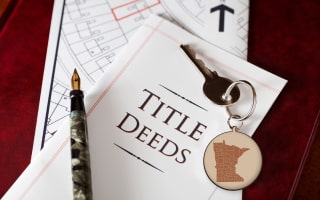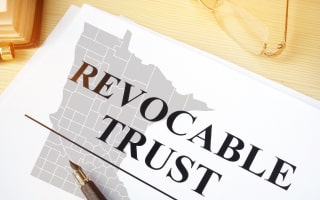How to Find Owners of Properties
in Minnesota

A property owner search in Minnesota starts with a search through public records. The research process would require a visit to the relevant public agency holding these records to make an official request or search via an online database if that is available. There are also third-party platforms that can help get these records on demand.
Here's how to use all these options to conduct a Minnesota house owner lookup.
Visit Your County Assessor's Office
Assessors are local government officials who check the value of properties in Minnesota. County assessors also verify property information for tax purposes to ensure that property owners pay the proper taxes that match their property's value.
They then keep these records in their offices across the state for interested members of the public to view on demand. Here are links to county assessors' offices in some major counties in Minnesota:
Browse County Property Search Portals
If you want to find the owner of a property free, some counties have online portals where you can do a property owner search in Minnesota. These portals only require you to create an account and enter relevant information, such as the property's parcel ID or property description. You can even find a property owner by address on some of these portals.
Here are some counties with property search portals in Minnesota:
Check Out the County Records Office
If you're looking to search for property owners in Minnesota, you can reach out to the county records office or the register of deeds. Each city or county has a designated office for this. Check out the records offices of these major counties via these links:
Outsource to a Title Search Agency
Apart from public offices, you can tap a title search agency to undertake a property owner search in Minnesota. A title search agency helps verify the authenticity of the seller's title. It can also check if the property is tied to a pending court case, loan, or other liens. However, unlike government agencies, title agencies are not free and charge a fee for their services.
![]() Turn to a Commercial Search Company
Turn to a Commercial Search Company
Commercial services like PropertyCheckers.com can help with a property owner search in Minnesota. The platform has an up-to-date database of all properties in the state and allows for multiple search options, like name, address, and phone number.
The search process is easy. Simply visit the website and input the required information to narrow the search, such as the property address, email, or parcel ID. The system will then run a quick scan among properties in its records and pull results that match the search data.
What Are the Different Types of Property Ownership in Minnesota?

There are many ways to own property in Minnesota. There is sole ownership, where one person has total rights over their property. There are also joint ownership systems for multiple owners, like joint tenancy and tenancy in common.
Understanding these different types of property ownership can help you make better decisions before buying any property in Minnesota.
Below are the most common categories of property ownership in Minnesota:
-
Tenancy in Common
Tenants in common share ownership of a property, with each owner having a clear share, depending on their contributed percentage. The right of survivorship, which allows one co-tenant to inherit the other's share when that tenant dies, does not apply here. Instead, the deceased's loved ones inherit their share of the property, depending on what is in their will.
Another characteristic of this type of ownership is that a co-owner cannot sell their share of the property without telling the other co-owners.
-
Joint Tenancy
A joint tenancy is like tenancy in common, except that parties have equal shares. However, the right of survivorship applies here. So, if one of the parties dies, their share automatically moves over to the surviving owner(s). Partners in this type of agreement cannot pass their share through their will.
Under a joint tenancy, an individual owner does not need permission from the other co-owners before selling their share of the property. The only implication is that the joint tenancy automatically ends. If the co-owners are married, a divorce will automatically end the joint tenancy and convert it into a tenancy-in-common.
-
Trust Ownership
Under a trust ownership, people can own property by being beneficiaries of a trust. A trust implies that property ownership moves from the first owner (grantor) to another person called the trustee. The trustee then manages the property on behalf of a third party, the beneficiary.
Summary Table of Minnesota's Property Ownership Types
| Ownership Structure | Description | Benefits | Implications |
|---|---|---|---|
| Sole Ownership | One person has an undivided interest in the property. | The sole owner has total control over the property. | The sole owner can do what they want with the property (e.g., sell or give it out) without consulting anyone. |
| Joint Tenancy | This ownership type has two or more persons with equal ownership rights to a property. | The right of survivorship allows owners to bypass the probate process. | When one party dies, the other tenants automatically take over their share of the property. |
| Tenancy in Common | Two or more persons own property together, in distinct, but not necessarily equal shares. | One of the parties can sell their share of the property without the permission of other co-owners. | A deceased co-tenant's share of the property can go to their heirs through their will. |
| Trust Ownership | Property ownership is transferred to a trust, which holds and manages it on behalf of the beneficiaries. | A trust guarantees privacy and is another way of avoiding the probate process. | There are complex tax obligations that may impact individuals in the pact. |
| Cooperative Ownership | In cooperative ownership, individual members own units on a property through their cooperative. | This property ownership type gives people access to affordable housing. | Members must pay dues and meet other obligations or lose their rights to the property. They also need the cooperative's approval to sell their shares. |
| Life Estate | The life tenant uses the property while alive. When they die, the beneficiary inherits it. | It is an easy way of bypassing the probate process. | The beneficiary inherits the life tenant's debts alongside the property. |
Finding the Owner of a Trust or Corporation That Owns Properties in Minnesota

In Minnesota, other entities apart from individuals can own properties. These include trusts, corporations, and limited liability companies. Doing a property owner search for these properties is tricky because the identities of the persons behind these companies are often hard to find.
Finding these persons may involve carefully reviewing public records, business databases, directories, and other research tools. Alternatively, professionals like real estate attorneys and title companies can do this search for a fee.
Below are some easy ways to find the owner of a trust, LLC, or corporation in Minnesota:
Finding the Owner of a Trust in Minnesota
The best way to trace the owner of a trust property in Minnesota is to conduct a property records search. The title documents may show the trustee's name at the relevant office, like the local recorder, making the search straightforward.
However, this is not always the case because trusts are private by nature, and sometimes, you may run into a dead end. In this case, hiring a real estate attorney to take up the search is advisable. Professionals are better equipped to conduct tricky searches like this.
Finding the Owner of an LLC in Minnesota
Finding the owner of an LLC in Minnesota is easy. The state has a business filing portal where interested persons can conduct a business name search.
Here's how to do a simple search:
- Visit the business filing portal.
- Input the business name or file number in the provided column.
- Click search.
A successful search will then reveal the business's current filing status and former names (if any).
Finding the Owner of a Corporation in Minnesota
Finding the owner of a corporation in Minnesota follows the same procedure as finding the owner of an LLC. Simply visit the business filing portal and follow the same steps above.
However, if the corporation is a bank or Insurance corporation, the best place to direct the search is the Department of Commerce, which has a License Lookup Directory with information on all license holders in the state.
Common Methods of Property Transfer in Minnesota

Property transfer in Minnesota is usually through a deed. This is an official document with the parties' names and other information on the property.
The most common types of property deeds in Minnesota are quitclaim, general warranty, and limited warranty.
-
Quitclaim Deed
Here, the seller does not make any promises to the buyer, especially regarding the property title. If the title is bad, or there is some debt or other encumbrance attached to the property, the buyer inherits it with the sale. Quitclaim deeds typically apply where the property is a gift or proceeds of a divorce.
-
General Warranty Deed
A general warranty deed is a promise from the seller to the buyer that they are the rightful owner of the property. If there are any problems after the sale, the buyer can sue for damages for the breach of warranty.
-
Limited Warranty Deed
The seller guarantees the buyer a valid title and an assurance that while the seller held the property, there were no issues. The implication is that this warranty does not cover pre-existing issues from before the seller took over the property. If these problems still exist, they will pass to the new owner.
Step-by-Step Guide to Property Transfer in Minnesota

When buying a property in Minnesota, the buck does not stop at paying the seller. It is also essential to understand every step involved in the process to protect yourself. If not for anything, ensure that the right thing is done and there will be no future problems.
Below is a step-by-step guide to what should happen when you're buying a property:
- Establish the Type of Transfer: First, determine what type of transfer is about to happen - a gift, inheritance, or sale. Knowing this will help determine what rules will apply to you, what taxes you are to pay, or if you are to even pay taxes.
-
Conduct a Title Search: Title search is one of the most important steps in a property transaction. As discussed earlier in this guide, a title search confirms whether the seller's title is valid and whether there are any issues with the property.
You can conduct this search using the earlier steps or get a title search company or real estate attorney to help. Title searches typically cost around $100 to $200 in Minnesota but can vary, depending on many factors.
- Draft a Deed: A deed is often the primary proof of the property transaction. It is advisable to get an attorney to draft one stating the terms of the agreement. Attorneys charge differently for this service, and there is no fixed rate, but it typically costs around $500 or more to get a property deed in Minnesota.
- Pay Transfer Taxes (Deed Tax): In Minnesota, a deed tax applies after the sale of a property. The seller is often responsible for paying this tax, although parties can agree to have the buyer pay it instead. The transfer tax/deed tax is typically 0.33% of the sales price, but it does not apply in special cases, like divorce settlements or where the government is one of the parties to the transaction.
- Record the Deed: After the sale, the next thing to do is record the property deed at the relevant government office, usually the local recorder's office. Recording the deed makes it part of public records so that it appears in any property title search.
- Update Relevant Records: After recording the deed, update the new owner's information at the local assessor's offices and other relevant offices. Doing this guarantees the new owner will receive all mail and bills for that property.
- Get Title Insurance: Although not a compulsory step, it is always advisable to get title insurance. It protects the new owner from any surprises that may spring up from the title, like unknown liens and debts that did come up during the title search. Title insurance in Minnesota typically costs around 0.5 to 1% of the sales price.
Property Ownership Guide
Minnesota Homeowner Lookup
- Owner(s)
- Deed Records
- Loans & Liens
- Values
- Taxes
- Building Permits
- Purchase History
- Property Details
- And More!